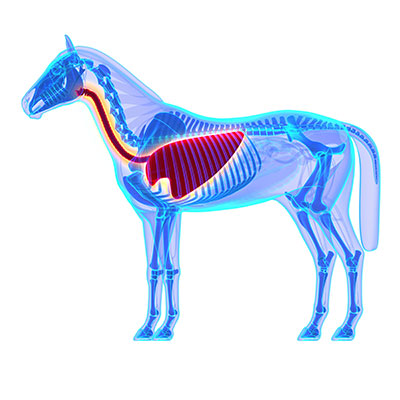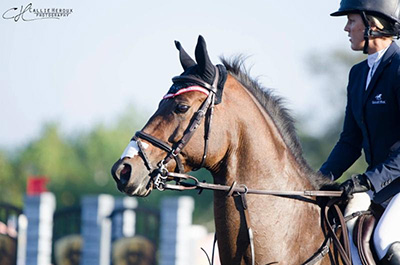
Airway inflammation is an often-undiagnosed cause of discomfort and compromised performance.
by Kim F Miller
Joint inflammation gets a lot of airtime in the equestrian world, and rightly so. It’s the root cause of arthritis and the crux of the time-worn veterinary adage: “There are two types of horses: those who have arthritis and those who will get it.” An industry has grown up around supplements, therapies and medical treatments to postpone and mitigate the damage inflicted by inflammation in the joints.
The reality is that inflammation anywhere in the horse’s body is bad news, especially in the airway and lungs. In fact, it’s a keyword in one of the most common non-infectious respiratory diseases: Inflammatory Airway Disease, and a culprit in IAD’s sister condition, Respiratory Airway Obstruction, often referred to as “heaves.”
IAD and RAO are points on a spectrum of conditions described by the American College of Veterinary Internal Medicine as “Equine Asthma.” That’s because they share with their human counterparts the underpinning of chronic airway inflammation. IAD represents the milder end of the Equine Asthma spectrum. It’s important to note, however, that a horse with IAD may be prone to develop the more severe manifestation, RAO, but it’s not a “continuum” in which IAD definitely progresses to RAO.

Just as in other parts of the body, inflammation is the body’s response to irritation and damage. In the airway, the irritant can be dust, allergens, bacteria, mold, fungal spores, etc. Nature’s design is that these airborne particles are caught by the microscopic, hair-like cilia in the trachea, secured by the sticky mucus there and flushed out when the horse exhales, coughs or lowers its head to graze. In reality, though, most horses don’t live in their natural habitat, so the flushing process doesn’t go as planned. Instead, particles settle in the windpipe or move through into the tissue lining the lungs. Along with these irritants, damage can be inflicted by a stray bit of hay or microscopic foreign body poking the lining of the windpipe.
The resulting inflammation narrows the airway itself and tightens the surrounding muscles, further constricting the free flow of air between the horse’s nostrils and lungs. (Horses can’t breathe through their mouth, by the way.) It also triggers the production of excess mucus, which the compromised airway has more trouble expelling.
The good news about inflammation in an equine respiratory context is that it’s most often caused by environmental factors that can be eliminated or greatly reduced. If caught in their early stages, non-infectious respiratory diseases can be addressed before resulting in long-term damage. “The most important factor in improving your horses’ heath is to decrease environmental irritants,” confirms the ACVIM’s fact sheet on the subject.
A Sneaky Suspect
Inflammatory Airway Disease is stealthy in its earliest and most mild stages. “A horse can have a serious problem with their respiratory system without having obvious symptoms to where the owner can’t pinpoint what’s going on,” explains Emmanuelle Van Erck-Westergren, DVM, PhD, ECEIM. “The horse can have lower airway inflammation and not necessarily have a cough, nasal discharge or heavy breathing.” Multiple studies confirm the presence of IAD in indoor-stabled horses with no symptoms. The incidence rate was even higher in a sample of 482 horses referred for normal check-ups, poor performance or respiratory concerns. Presented to the AVCIM in 2016 and conducted by Dr. Van Erck-Westergren and a European colleague, this study pool included IAD diagnosis in 84% of the participants.
While the symptoms of early respiratory challenges often elude owners, vets see them regularly. “Just as in older people, older horses have lungs that have seen a lot more respiratory challenges,” says Melanie “Wren” Burnley, DVM, a veterinarian and FEI-level dressage rider based in Fulton, Kentucky. “When you look at their respiratory tracts, you see they already have a start on scarring and the tissue has lost some of its elasticity.”
By “older,” Dr. Burnley means horses that are just hitting their peak from a training and performance standpoint: 10-year-olds and up, generally speaking. With even the earliest scarring and loss of elasticity, dust, spores and other airborne irritants can trigger inflammation in the airway and lungs, compromising comfort and performance. As an asthmatic athlete herself, she speaks from experience on this point.

IAD is most prevalent in young horses, from a year up. It can present as a cough that lingers for more than a month and, in older horses, performance that may seem fine in regular work, but falters inexplicably in competition. When examined with an endoscope, the airways will show excess mucus, which is what triggers the cough. Over time, a horse with IAD will breathe more heavily during regular exercise and take longer intervals to get back to normal breathing afterwards. If present at all, these symptoms can be very mild and the horse can otherwise seem quite healthy.
Respiratory Airway Obstruction represents the more severe end of the Equine Asthma spectrum. Its “heaves” nickname comes from the abdominal “heaving” required to exhale for horses with the condition. Disease progression follows the same initial sequence of events as those seen in a horse with IAD: Inhaled irritants or damaging particles trigger the inflammation response, swelling and constricting the airway and spurring extra mucus production that accumulates in the respiratory tract.
Formerly known as Chronic Obstructive Pulmonary Disease, RAO in earlier stages can be distinguished by heavy breathing at rest, exercise intolerance, nasal discharge, wheezing and coughing. In advanced stages, ROA can generate a “heave line” parallel to the underbelly, where the abdominal muscles are overdeveloped from the effort of exhaling.
Diagnosis & Treatment
The diagnostic process for Equine Asthma begins with a thorough examination and history, first seeking to rule out the possibility of an infectious respiratory disease with similar symptoms. Common examples in this category are Equine Herpesvirus, Equine Influenza and Equine Viral Arteritis. These typically are caused by bacteria, viruses or, occasionally, parasites.
Once a condition on the Equine Asthma spectrum has been determined, veterinarians use an endoscope, a long, small tube, to identify abnormal build-up of mucus that signals IAD or RAO. Additional tests include a lung wash, a bronchoalveolar lavage, to collect samples of the cells lining the airway passages within the lungs. A similar wash of the windpipe is another diagnostic option, all intended to distinguish IAD from infectious diseases and, ideally, to suggest specific causes.
Treatment begins with cleaning up the horse’s environment. Horses that live and move about freely outdoors have the least risk of exposure to Equine Asthma causes, but stable life can be easily and significantly improved by implementing horsekeeping habits aimed at improving air quality.
Stall bedding and hay are the biggest sources of respiratory irritants, no matter their quality. Shake a handful or flake of even top quality bedding or hay and it will emit a cloud of dust and particles.
Reducing stall bedding greatly reduces airborne particles. Sealed, cushioned stall flooring that requires absorptive material only where the horse urinates is ideal. It also eliminates urine-related ammonia odors that are another airway irritant. Providing ventilation and fresh air are more easy ways to minimize airborne respiratory irritants in the barn.
Regarding feed, cubed or pelleted hay are “cleaner” options than dry hay, as is soaking the hay. None are ideal solutions, however, because cubes and pellets are often less palatable and soaking hay leaches nutrients while adding the possibility of bacterial growth.

The relatively new concept of steaming hay has been proven to remove 99% of allergens, irritants, bacteria and other breathable particles, with the plus of retaining nutrients, increasing palatability and adding water to the horse’s diet.
“We’ve found that steaming hay will definitely remove the allergen sources from hay, helping horses with Equine Asthma, IAD and RAO,” reports Chad S. Davis, DVM. That’s a reference to studies conducted for Haygain®, which developed the process of steaming hay in partnership with the Royal Agricultural University in Cirencester, England. Beneficiaries include horses “that live with very low grade, often undiagnosed, versions of inflammatory airway disease,” Davis adds.
And horse people, too. First-hand experience made Dr. Burnley a steamed hay believer. “As an asthmatic athlete myself, I cannot stick my nose into a regular bale of hay, but I can in a bale that has come out of the Haygain machine.” A recent survey found that Wren is not alone when it determined that one in four people who work with horses has some sort of respiratory condition.
Placing hay on clean ground or in a low feeder that enables the horse to expel accumulated mucus is a smart step. When planning long distance travel, budget time to stop and feed the horse outside of the trailer. The quantity of inhaled irritants drastically increases as the horse spends hours with a pile of hay literally in its face.
If the case is severe or doesn’t respond to environmental changes, then medications are called for. Corticosteroids are the most common means of controlling respiratory inflammation. They are administered orally, by injection or inhaler.
Complete recovery and return to work and peak performance is typical for horses with Inflammatory Airway Disease. At the other end of the Equine Asthma spectrum, prolonged cases of RAO can result in permanent constriction of the airways that may prevent the horse from exerting itself. Medications can provide temporary relief, as they do for human asthma patients, but not a cure. Maintaining a clean, well-ventilated living environment for the ROA horse is the best way to keep it comfortable and breathing with relative ease. That’s the best protocol for horses on any point of the Equine Asthma spectrum and, most importantly, to keep them off the spectrum all together.
Find out more about Equine Therapy and the wide variety of Supplements that are available for a wide variety of concerns.

































